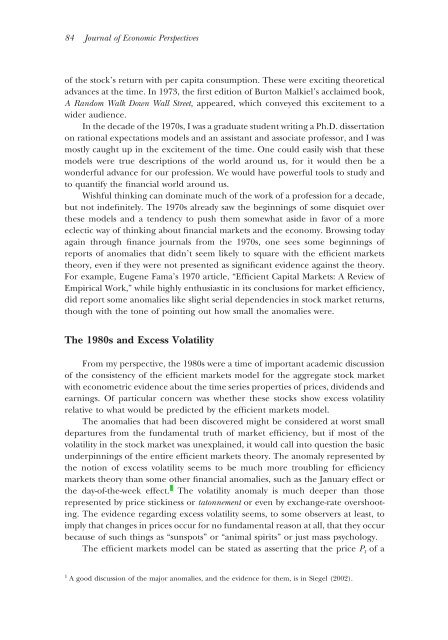From Efficient Markets Theory to Behavioral Finance
From Efficient Markets Theory to Behavioral Finance
From Efficient Markets Theory to Behavioral Finance
Create successful ePaper yourself
Turn your PDF publications into a flip-book with our unique Google optimized e-Paper software.
84 Journal of Economic Perspectives<br />
of the s<strong>to</strong>ck’s return with per capita consumption. These were exciting theoretical<br />
advances at the time. In 1973, the first edition of Bur<strong>to</strong>n Malkiel’s acclaimed book,<br />
A Random Walk Down Wall Street, appeared, which conveyed this excitement <strong>to</strong> a<br />
wider audience.<br />
In the decade of the 1970s, I was a graduate student writing a Ph.D. dissertation<br />
on rational expectations models and an assistant and associate professor, and I was<br />
mostly caught up in the excitement of the time. One could easily wish that these<br />
models were true descriptions of the world around us, for it would then be a<br />
wonderful advance for our profession. We would have powerful <strong>to</strong>ols <strong>to</strong> study and<br />
<strong>to</strong> quantify the financial world around us.<br />
Wishful thinking can dominate much of the work of a profession for a decade,<br />
but not indefinitely. The 1970s already saw the beginnings of some disquiet over<br />
these models and a tendency <strong>to</strong> push them somewhat aside in favor of a more<br />
eclectic way of thinking about financial markets and the economy. Browsing <strong>to</strong>day<br />
again through finance journals from the 1970s, one sees some beginnings of<br />
reports of anomalies that didn’t seem likely <strong>to</strong> square with the efficient markets<br />
theory, even if they were not presented as significant evidence against the theory.<br />
For example, Eugene Fama’s 1970 article, “<strong>Efficient</strong> Capital <strong>Markets</strong>: A Review of<br />
Empirical Work,” while highly enthusiastic in its conclusions for market efficiency,<br />
did report some anomalies like slight serial dependencies in s<strong>to</strong>ck market returns,<br />
though with the <strong>to</strong>ne of pointing out how small the anomalies were.<br />
The 1980s and Excess Volatility<br />
<strong>From</strong> my perspective, the 1980s were a time of important academic discussion<br />
of the consistency of the efficient markets model for the aggregate s<strong>to</strong>ck market<br />
with econometric evidence about the time series properties of prices, dividends and<br />
earnings. Of particular concern was whether these s<strong>to</strong>cks show excess volatility<br />
relative <strong>to</strong> what would be predicted by the efficient markets model.<br />
The anomalies that had been discovered might be considered at worst small<br />
departures from the fundamental truth of market efficiency, but if most of the<br />
volatility in the s<strong>to</strong>ck market was unexplained, it would call in<strong>to</strong> question the basic<br />
underpinnings of the entire efficient markets theory. The anomaly represented by<br />
the notion of excess volatility seems <strong>to</strong> be much more troubling for efficiency<br />
markets theory than some other financial anomalies, such as the January effect or<br />
the day-of-the-week effect. 1 The volatility anomaly is much deeper than those<br />
represented by price stickiness or ta<strong>to</strong>nnement or even by exchange-rate overshooting.<br />
The evidence regarding excess volatility seems, <strong>to</strong> some observers at least, <strong>to</strong><br />
imply that changes in prices occur for no fundamental reason at all, that they occur<br />
because of such things as “sunspots” or “animal spirits” or just mass psychology.<br />
The efficient markets model can be stated as asserting that the price P t of a<br />
1 A good discussion of the major anomalies, and the evidence for them, is in Siegel (2002).
















